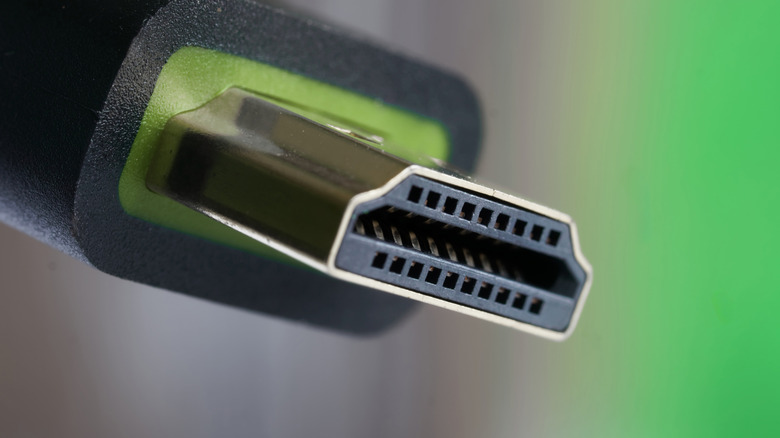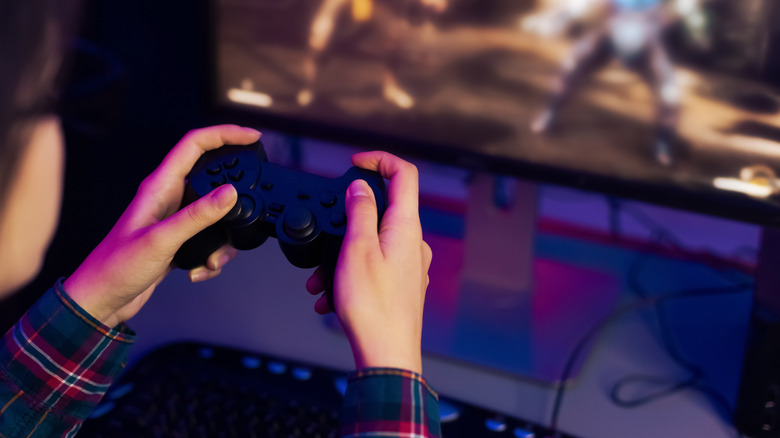HDMI 2.1 Vs 2.2: What's The Difference (And Why It Probably Won't Matter To You)
HDMI cables are nothing new, with them being involved in virtually all aspects of the technological world. They connect computers, video game consoles, Blu-ray players, and more to televisions and monitors, effectively transferring visual and audio data with ease. Simply plug them into the necessary devices and start engaging with your chosen form of media. While one might think that all HDMI cords floating around are the same, this isn't entirely true. Just as it can matter which HDMI port you use on your TV, depending on the HDMI cable in use, you can anticipate different levels of performance.
The current version of the HDMI cable is known as HDMI 2.1, the successor to HDMI 2.0. This format allows users a bandwidth of 48 Gbps, along with resolutions of 10K at 60Hz, 8K at 60Hz, and 4K at 120Hz, so it's no visual slouch. However, its successor, the aptly named HDMI 2.2, ups the ante seemingly quite a bit. This rising HDMI format boasts 96 Gbps — advertised as Ultra96 cables due to this — and 16K resolution support at 60Hz and 12K at 120Hz. It also features the Latency Indication Protocol, which polishes up audio and visual syncing while you watch TV or play video games.
On paper, HDMI 2.2 is an improvement over HDMI 2.1. Still, in the long run, these stats likely won't mean too much to the average user.
HDMI 2.2 will be a game changer in the future, not so much now
Overall, it appears that HDMI 2.2 is a big deal, offering improved resolution, bandwidth, and more than the previous cable iteration. However, the fact of the matter is, most modern video game, streaming, and general entertainment setups won't be able to take full advantage of these improvements. As it stands, most GPUs and other tech hardware currently on the market aren't capable of utilizing the cable type to its peak potential, so a lot of the advertised improvements will fall by the wayside. While not a traditional HDMI cable, the existing DisplayPort 2.1b cable is capable of 80Gbps, so many may find this cable a fine alternative to HDMI 2.2 when seeking to replace their HDMI 2.1.
With all of this in mind, what exactly is the point of the HDMI 2.2 if the bulk of potential users can't get much out of it? As it turns out, the creation of this cable wasn't done for no reason. This cable was largely created for the sake of future-proofing, meaning that in the future, it's expected that devices will be able to take full advantage of this cable type. At the time of its release, most common devices weren't capable of doing anything with 16K resolution or 8K at 120Hz. Thus, the idea is that monitors developed in the coming years, as well as virtual reality headsets, for example, will be able to make use of HDMI 2.2 and all it has to offer. So, for now, most won't find them to be among the HDMI cables worth their money. However, a select few may want to give it a try.
Who can get anything out of HDMI 2.2 currently?
As explained, the leap from HDMI 2.1 to 2.2 is negligible for the more casual tech user. Meanwhile, for those who like to be up on the latest innovations and guarantee themselves the best performance the market has to offer, it could be a worthwhile purchase. If you're highly specific when it comes to watching movies and TV shows, even having a robust home theater setup, HDMI 2.2's improved audio and crystal-clear images could be up your alley. Of course, just make sure that all your other hardware is compatible with the HDMI 2.2 setup. Failing to do so may be one of the major mistakes in home theater system installation.
Naturally, gamers who like to keep their setup as top-of-the-line as possible could benefit somewhat from HDMI 2.2 tech. Their PC or console gaming experience could improve noticeably thanks to reduced input lag and superior refresh rates, resulting in a cleaner, smoother gaming presentation. Of course, it must be reiterated that for gamers to thrive with HDMI 2.2, their setup — from their monitor to their gaming system of choice — should be up to the task of utilizing it. Otherwise, you're better off sticking with HDMI 2.1, as 2.2 would end up providing you a comparable experience to that of the previous HDMI iteration.
As the tenure of HDMI 2.2 begins, it will ultimately take time for the average consumer to enjoy all of its benefits. At least once monitors, gaming consoles, computers, and the like catch up to it, its strengths will become all the more noticeable and desirable.


